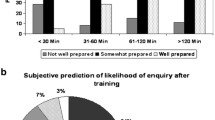Abstract
In 2012, the USPSTF updated its guidelines and now recommends that all women of childbearing age be screened for IPV and services provided for women who screen positive. Based on these recommendations, objectives of this study were to (1) evaluate IPV knowledge, attitudes, and practices of physicians from different specialties and (2) determine significant differences by medical specialty. We recruited (n = 183) Internal Medicine, Emergency Medicine, Family Medicine (FM) and Obstetrics/Gynecology (OB/GYN) residents and attending physicians to complete a 15-question online survey assessing knowledge, attitudes and current IPV screening practices. We evaluated associations between medical specialty and knowledge, attitudes and practice measures before and after controlling for covariates. Knowledge of how often IPV occurs in society, community resources, and screening tools were significantly different by specialty (all p’s < 0.05). A majority of FM physicians (88 %) reported that it is a physician’s responsibility to find and treat IPV and 97 % reported that IPV should be included in their training. Compared to OB/GYN physicians in multivariate analyses, FM physicians were less likely to report they were comfortable discussing IPV with their patients in crude (OR = 0.35; 95 % CI = 0.13, 0.94) and adjusted models (OR = 0.20; 95 % CI = 0.06, 0.60). FM physicians were also less likely to report screening female patients for IPV before (OR = 0.25; 95 % CI = 0.08, 0.86) and after adjusting for confounders (OR = 0.11; 95 % CI = 0.03, 0.47). Our results indicate that FM physicians have positive attitudes towards finding and treating IPV yet need enhanced training to improve their comfort level with screening for and discussing IPV with their patients.
Similar content being viewed by others
References
Moyer, V. A. (2013). Screening for intimate partner violence and abuse of elderly and vulnerable adults: A U.S. preventive services task force recommendation statement. Annals of Internal Medicine, 158(6), 478–486.
Screening Tools—Domestic Violence. (n.d.). In The American Congress of Obstetricians and Gynecologists. (2014). Retrieved from www.acog.org/About-ACOG/ACOG-Departments/Violence-Against-Women/Screening-Tools–Domestic-Violence
ACOG Committee Opinion No. 518: Intimate partner violence. (2012). Obstetrics and Gynecology, 119(2, Part 1), 412–417.
Parsons, L., Goodwin, M. M., & Petersen, R. (2000). Violence against women and reproductive health: Toward defining a role for reproductive health care services. Maternal and Child Health Journal, 4(2), 135–140.
Parker, B., McFarlane, J., & Soeken, K. (1994). Abuse during pregnancy: Effects on maternal complications and birth weight in adult and teenage women. Obstetrics and Gynecology, 84(3), 323–328.
McFarlane, J., Parker, B., & Soeken, K. (1996). Physical abuse, smoking, and substance use during pregnancy: Prevalence, interrelationships, and effects on birth weight. Journal of Obstetric, Gynecologic, and Neonatal Nursing, 25(4), 312–320.
Brown, J. B., Lent, B., Brett, P. J., Sas, G., & Pederson, L. L. (1996). Development of the woman abuse screening tool for use in family practice. Family Medicine, 28(6), 422–428.
Sherin, K. M., Sinacore, J. M., Li, X. Q., Zitter, R. E., & Shakil, A. (1998). HITS: A short domestic violence screening tool for use in a family practice setting. Family Medicine, 30(7), 508–512.
Gutmanis, I., Beynon, C., Tutty, L., Wathen, C. N., & MacMillan, H. (2007). Factors influencing identification of and response to intimate partner violence: A survey of physicians and nurses. BMC Public Health, 7, 12.
Sprague, S., Madden, K., Simunovic, N., et al. (2012). Barriers to screening for intimate partner violence. Women and Health, 52(6), 587–605.
ACGME Program Requirements for Graduate Medical Education in Family Medicine. (2013). Accreditation Council for Graduate Medical Education.
Women’s Health: Recommended Curriculum Guidelines for Family Medicine Residents. (2012). American Academy of Family Physicians.
Hamberger, L. K. (2007). Preparing the next generation of physicians: Medical school and residency-based intimate partner violence curriculum and evaluation. Trauma, Violence, & Abuse, 8(2), 214–225.
McColgan, M. D., Cruz, M., McKee, J., et al. (2010). Results of a multifaceted Intimate Partner Violence training program for pediatric residents. Child Abuse and Neglect, 34(4), 275–283.
Brienza, R. S., Whitman, L., Ladouceur, L., & Green, M. L. (2005). Evaluation of a women’s safe shelter experience to teach internal medicine residents about intimate partner violence. A randomized controlled trial. Journal of General Internal Medicine, 20(6), 536–540.
Sims, C., Sabra, D., Bergey, M. R., et al. (2011). Detecting intimate partner violence: More than trauma team education is needed. Journal of the American College of Surgeons, 212(5), 867–872.
Shakil, A., Gimpel, N., Ohagi, J., & Dobbie, A. (2009). A community action research experience (CARE) program for family medicine residents. Family Medicine, 41(3), 158–159.
Ramsay, J., Rutterford, C., Gregory, A., et al. (2012). Domestic violence: Knowledge, attitudes, and clinical practice of selected UK primary healthcare clinicians. British Journal of General Practice, 62(602), 647–655.
Papadakaki, M., Prokopiadou, D., Petridou, E., Kogevinas, M., & Lionis, C. (2012). Defining physicians’ readiness to screen and manage intimate partner violence in Greek primary care settings. Evaluation and the Health Professions, 35(2), 199–220.
Papadakaki, M., Petridou, E., Kogevinas, M., & Lionis, C. (2013). Measuring the effectiveness of an intensive IPV training program offered to Greek general practitioners and residents of general practice. BMC Medical Education, 13, 46.
Nulty, D. D. (2008). The adequacy of response rates to online and paper surveys: What can be done? Assessment & Evaluation in Higher Education, 33(3), 301–314.
Fincham, J. E. (2008). Response rates and responsiveness for surveys, standards, and the Journal. American Journal of Pharmaceutical Education, 72(2), 43.
Acknowledgments
We would also like to acknowledge Emeka Jay Ohagi, MPH, Barbara Foster, PhD and Amer Shakil, MD for their support and contribution to this project.
Conflict of interest
None.
Author information
Authors and Affiliations
Corresponding author
Rights and permissions
About this article
Cite this article
Pagels, P., Kindratt, T.B., Reyna, G. et al. Establishing the Need for Family Medicine Training in Intimate Partner Violence Screening. J Community Health 40, 508–514 (2015). https://doi.org/10.1007/s10900-014-9964-1
Published:
Issue Date:
DOI: https://doi.org/10.1007/s10900-014-9964-1



